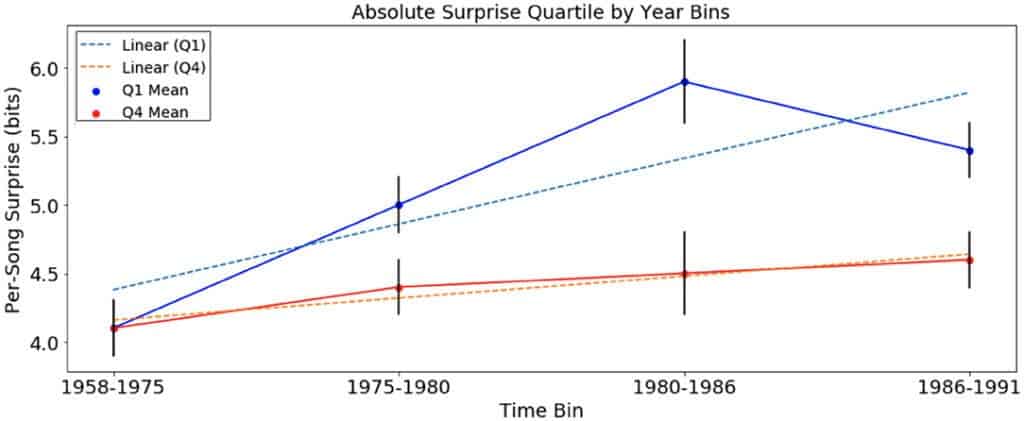
Although writing music is first and foremost a creative endeavor, this doesn’t mean that there aren’t compositional formulas that can dramatically increase the odds of a song sticking in people’s ears. The same thing goes for writing, painting, photography, comedy, and cinematography. Coming back to music, a new study has demystified some aspects that make a song popular, showing that harmonic surprise is an important factor in predicting which piece of music will be perceived as pleasurable.
What’s more, this preference evolves over time as we become accustomed to certain musicalities. Yesterday’s fresh music can grow old, so common harmonies in popular music need to be constantly shifting to catch the listener by surprise.
To reach this conclusion, researchers at Drexel University, Georgetown University, and Loyola University Chicago looked at all the Billboard hits from 1958 to 2019, analyzing the harmonic content of each song. With each passing decade, the harmonic surprise of the top tunes has been increasing, a phenomenon which the researchers have dubbed “inflationary surprise”.
What to write a top pop song? Be different
Why do we like certain pieces of music and dislike others? One prevailing theory is that music evokes a pleasurable response in the human brain depending on the degree to which a song adheres or deviates from what a listener would expect. When we hear familiar songs that sound good to our ears, the brain stimulates a neural reward. This stimulation can equally occur when we hear certain novel types of songs that don’t necessarily adhere to the sound of what we usually listen to.
This notion explains why there is a great deal of variability in musical preferences or why we label some songs as retro and boring while others are fresh and hot. In other words, musical perception is partly based on cultural knowledge.
It follows that surprise in music is an important factor in predicting the popularity of a musical piece. Quantifying a song’s total amount of surprise is possible by analyzing its distinct components, such as harmonies, melody, rhythm, and timbre.
Music that is more likely to cause a pleasurable reaction to listeners tends to place higher on charts, which is why the researchers led by neuroscientist Scott Miles turned to the Billboard Hot 100 as an approximation of popularity and musical reward for their analysis of harmonic surprise.
Previously, in a different study, the researchers proposed two hypotheses as to how surprise affects musical perception. The Absolute-Surprise Hypothesis states that musical popularity is determined by the overall amount of surprise in a piece, based on the notion that dopamine (the ‘feel good’ neurotransmitter) is associated with novelty. The Contrastive-Surprise Hypothesis is not dependent on the total amount of surprise in a song but rather on the contrast between high-surprise and low-surprise sections within a certain song.
In a 2017 study, Miles and colleagues had analyzed the Hot 100 songs, from Bee Gees’ How Deep Is Your Love to Mariah Carey’s We Belong Together, looking for patterns of sounds that may elicit a pleasurable response in the brain. They found that the most popular songs had a high level of harmonic surprise, including the use of rare chords in verse, following by a more conventional, catchy progression in the chorus. Later, the researchers also added other harmonic patterns to their scoring algorithm, including melody, timbre, lyrics, and rhythm, to devise software that can predict if a song will be well received by listeners.
However, this particular study assumed that the “expected” harmony of music was constant over the years across Western popular music — this turned out not to be the case.
To be successful, a musician needs to be constantly innovating

“This assumption, however, may not have been valid; it is entirely possible that the common harmonies which can be reasonably expected to occur in music may change from year to year,” the researchers wrote.
Instead, in this new research, Miles and colleagues went back to the drawing board and devised a more sophisticated model that analyzed how musical perception and preferences evolve over time along with surprising musical content.
They grouped Hot 100 songs into four time “bins” (each spanning about five years of release dates) and calculated the degree of harmonic surprise for each song. This analysis showed that harmonic surprise increases over time and is more pronounced in the most popular hit songs.
“Such dynamic harmonic expectations highlight the interactions between individual listeners and musicians with the culture around them. The Surprise-Inflation Hypothesis raised by the results presented here suggests that the brain’s craving for surprise causes continuous changes in harmonic distributions in popular music. A musician exposed to changes advanced by other musicians must innovate to be successful. It could be that musicians, learning from the success of high-surprise songs from one year, end up producing more high-surprise songs the next year. This could be an explicit strategy to improve on the part of musicians, rather than an implicit change in expectation on the part of the listeners. However, listeners’ preferences change as a result, forcing musicians to incorporate further changes. Hence, the inherent craving for surprise in each of us may push our entire culture in an endless evolution of musical preferences,” the researchers conclude in the journal Frontiers in Human Neuroscience.






